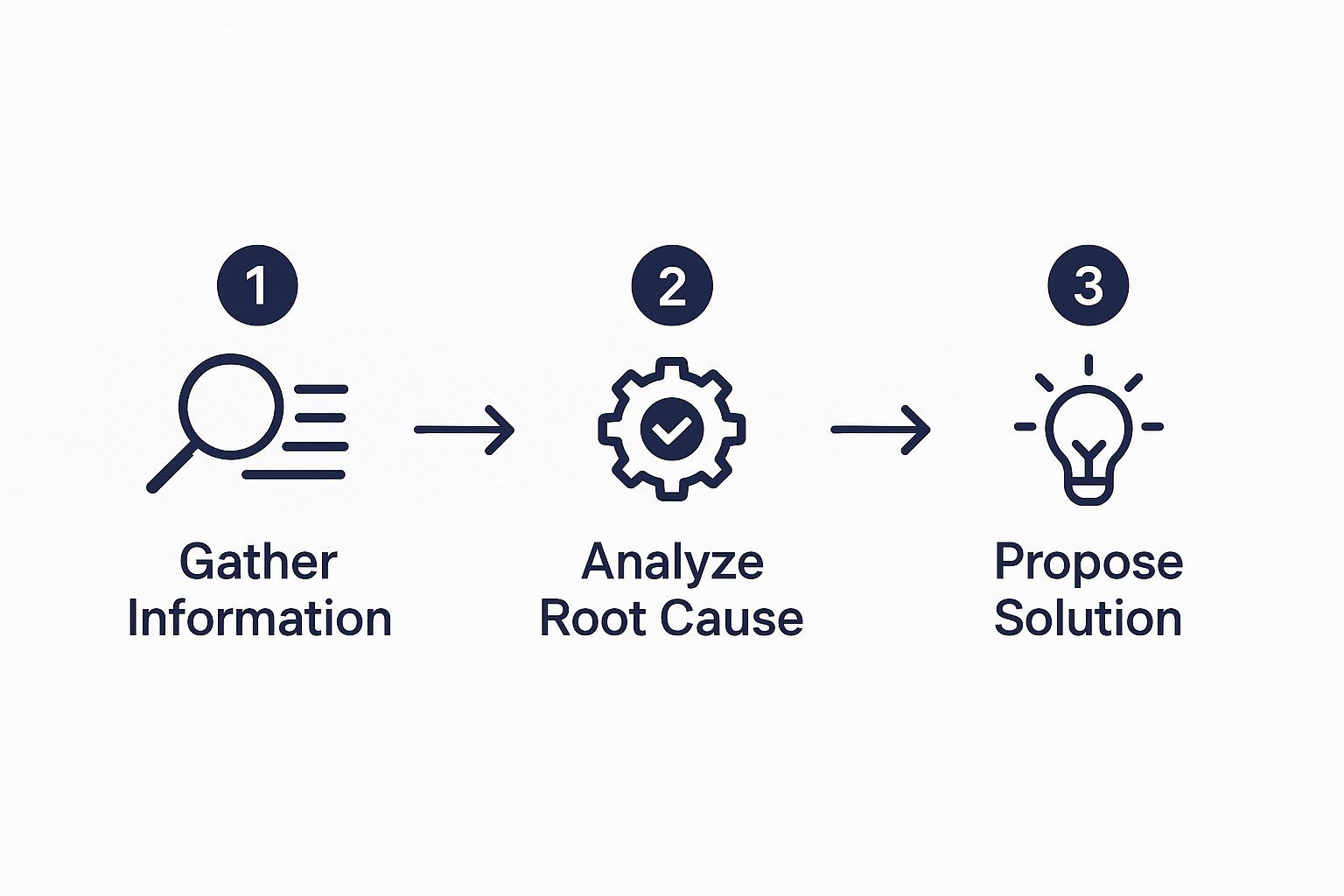How to Handle Client Complaints and Build Loyalty

Receiving a client complaint can feel like a major setback, but it's actually one of the most valuable interactions you can have in your business. It's not a sign of failure; it's a direct opportunity to demonstrate your commitment to quality and service.
Effectively handling a complaint means turning a negative experience into a positive one. It's a chance to listen, acknowledge the issue, provide a solution, and follow up to prove you genuinely care. Mastering this process is how you build unshakable trust and can even turn an unhappy client into a loyal advocate for your brand.
Why Client Complaints Are Hidden Opportunities

It’s natural to feel defensive when someone criticizes your work. However, try to view complaints as raw, unfiltered feedback that provides a clear roadmap for improvement. Each piece of criticism is a chance to make things right and reinforce your commitment to excellence.
This shift in perspective is crucial. While praise is encouraging, it's the complaints that highlight blind spots in your services, communication, or operational processes. To truly leverage this feedback, you need a plan for handling customer complaints and turning them into positive experiences.
The High Stakes of Every Interaction
In the beauty industry, your reputation is everything. A single poorly handled complaint can cost you that client and anyone they share their experience with. The data supports this: a staggering 57% of customers will switch to a competitor after just one negative experience. Every interaction truly matters.
A great resolution doesn't just save a client; it creates a brand advocate. People are far more likely to share stories of how a business went above and beyond to fix a problem than they are to talk about a standard, uneventful service.
This guide provides actionable steps for turning these tough situations into wins for your business. Think of it as protecting your hard-earned reputation—a critical part of your brand's defense.
Mastering Your Immediate Response
The first 24 hours after receiving a complaint are critical. This is your window to de-escalate the situation and establish a positive, solution-focused tone.
Your immediate goal isn't to solve the entire problem instantly. It's to make the client feel heard and valued. Your initial response can determine the outcome of the entire interaction. Avoid generic, automated replies like, "We received your message." Instead, use a personalized approach that shows you've paid attention.
Here is an actionable script for your first contact:
"Thank you so much for bringing this to our attention. I've personally read through your concerns about the [specific issue with their service], and I want to assure you we are looking into this immediately."
This simple statement conveys both urgency and empathy. It acknowledges their specific problem without prematurely admitting fault or making promises you can't keep.
Practice Active Listening
Active listening is a core skill for handling complaints effectively. It involves understanding the emotion and core frustration behind the client's words. A practical way to do this is to paraphrase their concerns back to them.
Actionable Tip: Repeat their issue in your own words. For example: "So if I'm understanding correctly, the main frustration was with the wait time and how it impacted the rest of your day." This confirms you've grasped the situation and shows them you’re on the same page.
This technique builds a foundation of trust before you even begin discussing solutions. It proves you understand the problem from their perspective.
Equip Your Team for Success
Your team is on the front lines and needs to feel confident managing these initial conversations. Providing them with clear scripts and guidelines is essential.
Effective customer service training for staff empowers your team to respond with empathy and professionalism, ensuring every client interaction is handled with care from the very first moment. This initial interaction is your opportunity to build a bridge from frustration to resolution.
Getting to the Root Cause and Finding the Right Fix
After listening to your client and acknowledging their concerns, it's time to investigate the issue. To find a lasting solution, you need to dig deeper than the surface-level frustration and identify what went wrong. The goal is to separate emotion from the facts.
Your first step is to gather all relevant information without assigning blame. This isn't about finding who was "wrong," but about building a complete picture of the situation to move past assumptions and pinpoint the real problem.
This flow chart visualizes a logical process for moving from understanding to action, rather than just guessing at a solution.

As you can see, a solid resolution is built on a foundation of good information.
Your Go-To Investigation Toolkit
To get to the bottom of the issue, investigate from multiple angles. Never rely on just one side of the story.
- Step 1: Check your records. Review your client files, emails, and text messages. Look for discrepancies between what was discussed and what was delivered. The answer is often documented.
- Step 2: Talk to your team. Speak with your staff privately. Instead of asking, "What did you do wrong?" try, "Can you walk me through the appointment from your perspective?" This encourages honest feedback, not defensiveness.
- Step 3: Review the client's history. Is this a one-time issue, or is there a pattern? A loyal, long-term client who has never complained deserves a different approach than a new client who has had issues from the start.
This investigation is crucial, as 67% of customer churn is preventable if the problem is solved during the first interaction.
The real goal here is to find the breakdown. Was it a simple miscommunication? A technical slip-up with a product? Or was it a case of mismatched expectations? You can't choose the right solution until you truly understand the "why" behind the complaint.
Once you have the full picture, you can propose a fair resolution for both the client and your business. This careful detective work rebuilds trust and proves your commitment to quality.
Comparing Common Complaint Resolution Tactics
Before deciding on a fix, weigh your options. Different situations call for different tactics. Use this table to choose the best course of action.
| Resolution Tactic | Best For | Client Satisfaction Impact | Business Impact |
|---|---|---|---|
| Full Refund | Major service failures or when the relationship is beyond repair. A last resort. | High. Shows complete accountability. | High. Direct financial loss; use sparingly. |
| Partial Refund/Discount | Minor issues where the service was mostly successful but had a specific flaw. | Medium to High. Often seen as a fair compromise. | Medium. Mitigates full financial loss while acknowledging the issue. |
| Complimentary Redo | Technical errors that can be corrected (e.g., chipped polish, uneven color). | High. Gives you a second chance to deliver the promised result. | Low to Medium. Costs time and product but retains the client and revenue. |
| Free Product or Service Credit | When the issue was an inconvenience rather than a service failure. | Medium. A nice gesture that encourages a future visit. | Low. Low hard cost, high perceived value for the client. |
| Sincere Apology & Explanation | Very minor issues or misunderstandings where no financial fix is needed. | Varies. Effective for loyal clients who value the relationship. | Minimal. Costs nothing but builds goodwill if the apology is genuine. |
Choosing the right tactic is a strategic business decision that protects both your reputation and your bottom line. A complimentary redo, for instance, often provides the best return by directly fixing the problem and reinforcing the client's original decision to book with you.
Communicating Your Solution and Following Through

You've investigated the issue and decided on a fair solution. Now, it's time for the most critical conversation. How you present the resolution is just as important as the solution itself. This is your opportunity to rebuild the relationship by taking full ownership.
Don't just state what you're going to do. Frame the conversation around accountability. Clearly and humbly explain what went wrong and what you're doing to fix it—both for them and for your business long-term.
Here is a script you can adapt:
"After looking into what happened, I realized we had a gap in our consultation process that led to this misunderstanding. To make this right, we'd love to offer you [your solution]. We're also updating our client intake forms immediately to make sure this never happens again to anyone."
This approach validates their feelings by identifying a specific cause and demonstrates that you’re making systemic improvements. This level of transparency is key to handling client complaints effectively.
The Power of the Follow-Through
Once the solution has been delivered and the client seems satisfied, your work isn't quite done. The follow-up is the step that elevates good customer service to an unforgettable experience.
Actionable Tip: Send a brief check-in message a week later. A simple text like, "Hi [Client Name], just wanted to follow up and make sure you were completely happy with everything," shows an ongoing commitment to their satisfaction.
This small action proves you care beyond just resolving a complaint. It reinforces that their happiness is your top priority and can turn a negative experience into a renewed—and often stronger—client relationship. It's a small investment of time that yields significant returns in client loyalty.
Turning Feedback Into Systemic Business Growth
If you only fix client complaints on a case-by-case basis, you're missing a major opportunity. Smart business owners know how to handle complaints by using them as free consultations to improve their entire operation.
The goal is to shift from reactive fixes to proactive system-building. The first step is to start a simple complaint log to track and categorize every piece of feedback you receive.
From Individual Issues to Actionable Insights
Once you begin logging complaints, you'll start to notice patterns. Are you frequently hearing about appointment delays on Saturdays? Are multiple clients confused by your aftercare instructions for a specific service? This data is invaluable.
By analyzing these trends, you can identify underlying issues within your business systems. This isn't about blaming your team; it's about spotting and strengthening weak links.
A single complaint is an anecdote. A pattern of complaints is a business problem demanding a systemic solution, not just another apology.
Client expectations are higher than ever, with customer contact volumes having increased by 71% since 2020. Ignoring these patterns is a significant missed opportunity for growth.
Implementing Lasting Change
Armed with this data, you can make meaningful changes that prevent future issues. This is how you turn negative feedback into a powerful engine for growth. To secure long-term success, you must address foundational problems. You might even explore strategies to improve data quality to ensure your insights are accurate.
Here are actionable steps you can take based on your findings:
- Refine Workflows: If booking errors are a common complaint, redesign your client intake or scheduling process.
- Update Team Training: If complaints point to inconsistent service quality, implement a skills workshop or update your training protocols.
- Evolve Services: If feedback on a new offering is consistently negative, use that data to either improve it or remove it from your menu.
This proactive approach ensures you’re not just solving today's problem but building a stronger, more resilient business that excels at meeting client needs—a crucial part of learning how to build client loyalty.
Your Burning Questions About Handling Complaints, Answered
Even with a solid plan, you'll encounter difficult situations. Knowing how to handle complaints often comes down to having a prepared strategy for challenging moments. Here are practical answers to common questions from business owners.
What if a Client Trashes My Business in an Online Review?
First, stay calm. A negative review is not the end of the world; it's an opportunity to demonstrate your professionalism to a public audience.
Your action plan is simple: address it publicly, resolve it privately.
Step 1: Post a calm, professional reply directly on the review platform. Your goal is not to argue but to acknowledge their feelings and move the conversation offline. Use this script: "We're so sorry to hear your experience didn't meet your expectations. That's not the standard we aim for. Please email us at [email] so we can make this right." This shows potential clients that you listen and care.
Step 2: Once they contact you privately, use your resolution framework to address the issue. After they are genuinely satisfied with the solution, you can gently ask, "We'd be so grateful if you'd consider updating your review." Never make this a condition for your help.
How Do I Get My Team to Handle Complaints Without Me?
You can't be everywhere at once. Empower your team by giving them the tools and trust to resolve issues independently.
- Create a playbook: Develop a simple guide with pre-approved responses and solutions. Define what they can offer on the spot (e.g., a discount, a complimentary add-on).
- Role-play scenarios: During team meetings, practice handling complaints using real, anonymous examples. This builds confidence for real-life situations.
- Grant them authority: Allow your team to offer a small compensation, like a 10% discount or a service credit, without needing your approval. This enables faster resolutions and shows you trust their judgment.
Finally, make it a habit to review complaints as a team to identify learning opportunities and patterns.
The goal is to give your team the confidence and authority to solve problems right then and there. A client whose issue is fixed in that first interaction is way more likely to walk out happy and come back.
Is It Ever Okay to "Fire" a Client?
Yes. While it should always be a last resort, it is sometimes necessary for the health of your business and the well-being of your team.
If a client is consistently disrespectful, makes unreasonable demands, or consumes so much time and energy that it negatively impacts your other clients, it may be time to part ways.
This should be handled as a professional disengagement, not a confrontation. Draft a calm, clear email explaining that you feel your business may no longer be the best fit for their needs. Keep it simple, polite, and final. Tie up any loose ends, such as providing necessary aftercare information. Your objective is to end the relationship professionally to protect your business and team from further conflict.
Ready to build a stunning website that attracts your ideal clients and makes managing your beauty business a breeze? With gohappybeauty, you get an SEO-optimized site designed specifically for your industry. Start your free trial today and see how easy it is to grow your brand online. Get started with gohappybeauty.
Grow your beauty business
Our focus is, and always will be, helping you improve your online presence and generate more business from your website. That is what we do, for you.

